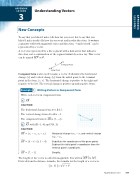Page 852 - Algebra 1
P. 852
APPENDIX
L E3S S O N Understanding Vectors
New Concepts
To say that you biked 3 miles tells how far you went, but to say that you biked 3 miles north tells how far you went and in what direction. A vector is a quantity with both magnitude (size) and direction. “3 miles north” can be represented by a vector.
A vector is represented by a line segment with a half-arrow that indicates direction, not a continuation of the segment infinitely as in a ray. This vector can be named M N or ν .
N
Terminal Point
v M
Initial Point
Component form is also used to name a vector. It identifies the horizontal change (x) and vertical change (y) from the initial point to the terminal point in the form, 〈x, y〉. The horizontal change is positive to the right and negative to the left. The vertical change is positive up and negative down.
Writing Vectors in Component Form
Write each vector in component form.
a. A B
SOLUTION
The horizontal change from A to B is 5. The vertical change from A to B is -2. The component form of A B is 〈5, -2〉.
b. R S with R(-1, 4) and S(6, 3). SOLUTION
Example
1
A
B
R S = 〈x2 - x1, y2 - y1〉 R S = 〈6 - (-1), 3 - 4〉
R S = 〈7, - 1〉
The length of the vector is called its magnitude. It is written ⎪E F ⎥ or ⎪ν ⎥.
Derived from the distance formula, the formula for the length of a vector is ⎪ 〈 a , b 〉 ⎥ = √ a 2 + b 2 .
Horizontal change is x2 - x1 and vertical change isy2 -y1.
Substitute the coordinates of the given points. Subtract the initial point’s coordinates from the terminal point’s coordinates.
Simplify.
Appendix Lesson 3 837
APPENDIX LESSONS


